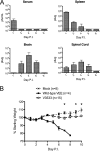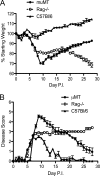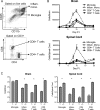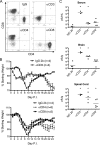T cells facilitate recovery from Venezuelan equine encephalitis virus-induced encephalomyelitis in the absence of antibody
- PMID: 20181704
- PMCID: PMC2863737
- DOI: 10.1128/JVI.02545-09
T cells facilitate recovery from Venezuelan equine encephalitis virus-induced encephalomyelitis in the absence of antibody
Abstract
Venezuelan equine encephalitis virus (VEEV) is a mosquito-borne RNA virus of the genus Alphavirus that is responsible for a significant disease burden in Central and South America through sporadic outbreaks into human and equid populations. For humans, 2 to 4% of cases are associated with encephalitis, and there is an overall case mortality rate of approximately 1%. In mice, replication of the virus within neurons of the central nervous system (CNS) leads to paralyzing, invariably lethal encephalomyelitis. However, mice infected with certain attenuated mutants of the virus are able to control the infection within the CNS and recover. To better define what role T cell responses might be playing in this process, we infected B cell-deficient microMT mice with a VEEV mutant that induces mild, sublethal illness in immune competent mice. Infected microMT mice rapidly developed the clinical signs of severe paralyzing encephalomyelitis but were eventually able to control the infection and recover fully from clinical illness. Recovery in this system was T cell dependent and associated with a dramatic reduction in viral titers within the CNS, followed by viral persistence in the brain. Further comparison of the relative roles of T cell subpopulations within this system revealed that CD4(+) T cells were better producers of gamma interferon (IFN-gamma) than CD8(+) T cells and were more effective at controlling VEEV within the CNS. Overall, these results suggest that T cells, especially CD4(+) T cells, can successfully control VEEV infection within the CNS and facilitate recovery from a severe viral encephalomyelitis.
Figures






Similar articles
-
Early activation of the host complement system is required to restrict central nervous system invasion and limit neuropathology during Venezuelan equine encephalitis virus infection.J Gen Virol. 2012 Apr;93(Pt 4):797-806. doi: 10.1099/vir.0.038281-0. Epub 2011 Dec 28. J Gen Virol. 2012. PMID: 22205717 Free PMC article.
-
Replication and clearance of Venezuelan equine encephalitis virus from the brains of animals vaccinated with chimeric SIN/VEE viruses.J Virol. 2006 Mar;80(6):2784-96. doi: 10.1128/JVI.80.6.2784-2796.2006. J Virol. 2006. PMID: 16501087 Free PMC article.
-
Alpha-beta T cells provide protection against lethal encephalitis in the murine model of VEEV infection.Virology. 2007 Oct 25;367(2):307-23. doi: 10.1016/j.virol.2007.05.041. Epub 2007 Jul 5. Virology. 2007. PMID: 17610927 Free PMC article.
-
Role of Angiotensin II in Venezuelan Equine Encephalitis: Narrative Review.Rev Med Virol. 2025 May;35(3):e70040. doi: 10.1002/rmv.70040. Rev Med Virol. 2025. PMID: 40317791 Review.
-
Current Understanding of the Molecular Basis of Venezuelan Equine Encephalitis Virus Pathogenesis and Vaccine Development.Viruses. 2019 Feb 18;11(2):164. doi: 10.3390/v11020164. Viruses. 2019. PMID: 30781656 Free PMC article. Review.
Cited by
-
Neuropathogenesis of Encephalitic Alphaviruses in Non-Human Primate and Mouse Models of Infection.Pathogens. 2025 Feb 14;14(2):193. doi: 10.3390/pathogens14020193. Pathogens. 2025. PMID: 40005568 Free PMC article. Review.
-
Rift Valley fever virus clearance and protection from neurologic disease are dependent on CD4+ T cell and virus-specific antibody responses.J Virol. 2013 Jun;87(11):6161-71. doi: 10.1128/JVI.00337-13. Epub 2013 Mar 27. J Virol. 2013. PMID: 23536675 Free PMC article.
-
CD8+ T cells control Ross River virus infection in musculoskeletal tissues of infected mice.J Immunol. 2015 Jan 15;194(2):678-89. doi: 10.4049/jimmunol.1401833. Epub 2014 Dec 8. J Immunol. 2015. PMID: 25488988 Free PMC article.
-
Live, Attenuated Venezuelan Equine Encephalitis Virus Vaccine (TC83) Causes Persistent Brain Infection in Mice with Non-functional αβ T-Cells.Front Microbiol. 2017 Jan 26;8:81. doi: 10.3389/fmicb.2017.00081. eCollection 2017. Front Microbiol. 2017. PMID: 28184218 Free PMC article.
-
Genetic ablation of arginase 1 in macrophages and neutrophils enhances clearance of an arthritogenic alphavirus.J Immunol. 2012 Oct 15;189(8):4047-59. doi: 10.4049/jimmunol.1201240. Epub 2012 Sep 12. J Immunol. 2012. PMID: 22972923 Free PMC article.
References
-
- Aronson, J. F., F. B. Grieder, N. L. Davis, P. C. Charles, T. Knott, K. Brown, and R. E. Johnston. 2000. A single-site mutant and revertants arising in vivo define early steps in the pathogenesis of Venezuelan equine encephalitis virus. Virology 270:111-123. - PubMed
-
- Bergmann, C. C., C. Ramakrishna, M. Kornacki, and S. A. Stohlman. 2001. Impaired T cell immunity in B cell-deficient mice following viral central nervous system infection. J. Immunol. 167:1575-1583. - PubMed
-
- Bernard, K. A., W. B. Klimstra, and R. E. Johnston. 2000. Mutations in the E2 glycoprotein of Venezuelan equine encephalitis virus confer heparan sulfate interaction, low morbidity, and rapid clearance from blood of mice. Virology 276:93-103. - PubMed
-
- Bilzer, T., and L. Stitz. 1994. Immune-mediated brain atrophy. CD8+ T cells contribute to tissue destruction during borna disease. J. Immunol. 153:818-823. - PubMed
-
- Binder, G. K., and D. E. Griffin. 2001. Interferon-gamma-mediated site-specific clearance of alphavirus from CNS neurons. Science 293:303-306. - PubMed
Publication types
MeSH terms
Substances
Grants and funding
LinkOut - more resources
Full Text Sources
Research Materials

